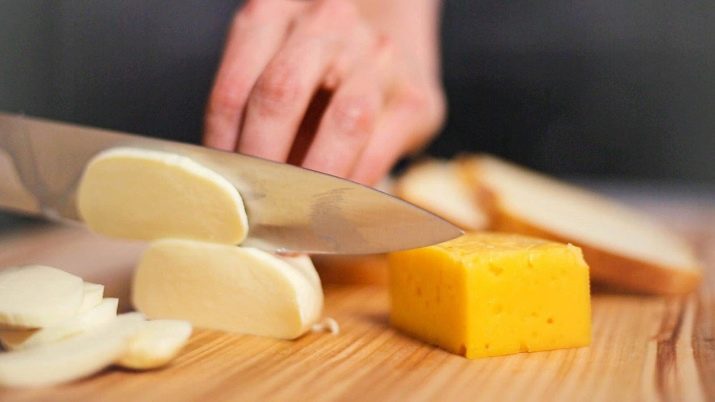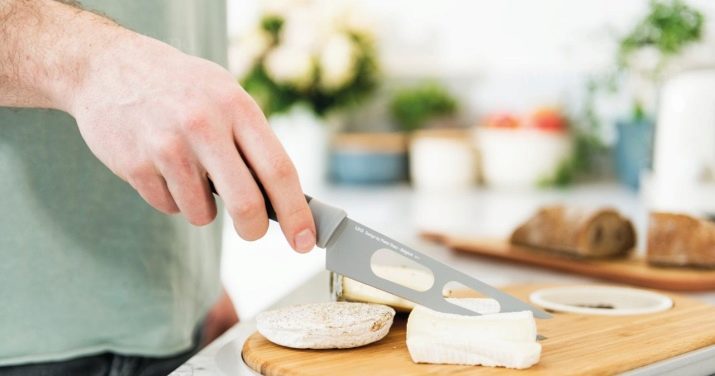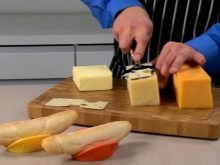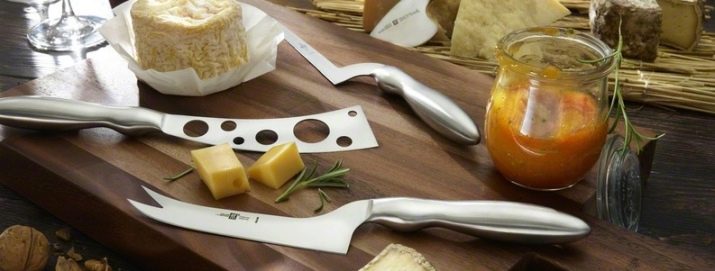Cheese knives: how to choose and use?

Many people love cheese. But cutting it with ordinary knives is a very dubious pleasure. It is very important to select a specialized cutting tool that will handle this task properly.
Peculiarities
Sandwich cheeses can be cut with ordinary blades without any problems. But any professional culinary specialist and even just a gourmet cannot agree with such a decision. Cheese knives can be different. When creating a knife, the specific gravity and consistency of each product are taken into account. A cheese knife for cutting especially soft varieties (dor blue and similar varieties) is not suitable, according to professionals and experts, for cheese of a slightly higher strength. In turn, both of these types of knives will not cope effectively enough with strong and extremely durable varieties of the product.

The taste of good cheese is unevenly distributed over the weight of the piece. Even moving from the middle to the edges, gourmets recognize the shades of taste. Therefore, lovers of this product believe that all the pieces should be cut with the expectation of smooth changes in taste. The vast majority of cheese knives are equipped with a handle located above the blade. This pattern makes cutting much easier and provides even pressure along the entire line. As a result, breaking and crumbling of the product is excluded.

The length of the cheese knife should reach 0.37 m, it includes a blade of 0.24 m and a handle of 0.13 m. The blade should not be too thick - the maximum permissible metal layer is 1.6 mm. In this case, the maximum length of the blade can be only 0.4 m. A deviation of even 1 mm in excess of the permissible dimensions is not allowed.
Sharpening the cheese knife should be done at an angle of strictly 20 degrees (for hard varieties) or 15 (if you need to process soft cheeses).
For cutting combined grades, along with straight knives, string attachments, paddles and a number of other structures can be used.



Important: If the knife is equipped with a ceramic blade, it is not suitable for slicing cheese. The pottery simply destroys the cheese and prevents it from being sliced properly.
Normally, the points are made from stainless steels with a high carbon content. Damascus steel is a classic example. More modern alloys with a similar composition can be used. The handle can be different, it is selected individually. Many experienced chefs believe that metal and fire-resistant plastics are definitely inferior to wood.

Varieties
But it is impossible to limit oneself to general requirements. Even if a cheese knife looks the same as a regular knife, it actually works differently. The classic version is a long knife with an ergonomic handle structure. Designers of the company Samura, who developed this version, provided for the use of a wavy incisal edge. Special "air pockets" prevent cheese fragments from sticking to the surface of the knife. The descriptions indicate that the blade-to-handle joint is raised. This allows you to distribute the loads as correctly as possible.

Professional chefs occasionally come across more unique tools, such as:
- parmesan knife;
- two-handed blade;
- grater knife;
- cheese planer.




Professional devices are usually narrowly specialized. Sometimes they are designed to process one or more types of cheese. Therefore, their purchase is not too much in demand. The classic modifications are good because they process both hard and soft cheeses quite well. The vast majority of versions use bactericidal bolster, helping to efficiently cut aged cheeses.

Products with two handles are usually used for cutting very large heads. A common tool does not do this very well. And a device called grease... It looks simple and unassuming, but it effectively solves the task. With the help of grease, it is easy to cut:
- Swiss tet de moine;
- edam;
- smoked cheese brands;
- petit basque.
This tool is used in other cases as well. He is able to make chocolate “curls” that look elegant on homemade baked goods. As the fat rotates, it forms shavings that look like lace. It is ideal for decorating various dishes. Externally fat is a round object with a central pin on which a cheese head is placed. Then the blade and handle are twisted. Rotation results in cutting off the upper layers with a sharp edge. These layers become neat, lace-like shavings.


The spatula is a knife for soft cheeses. It looks like a hatchet, and the tool ends in a thin blade. The wooden handle is designed for a comfortable grip, so cutting the product is quick and easy.

The traditional paddle allows you to adjust the pressure. Therefore, it becomes possible to make pieces of precisely specified thickness. Another kind of scapula - a knife with a side blade similar to a fork. A similar product is widely used to work with delicious cheeses. There are also shoulder blades with an oblong part: they are needed to spread ricotta or almette.

For processing soft cheese, use string knife. Such a cheese slicer is able to turn even the least solid product into cubes with neat edges. This is the perfect solution for blue mold cheese, which turns into an incomprehensible crumb under the blade of an ordinary knife. But high quality strings can handle a moderately stiff product.
It is customary to classify string constructions into platform constructions and those intended for manual work. Stands come in different materials:
- wood (bamboo is especially often used);
- non-corrosive steel grades;
- glass.



Hand and platform cheese knives can cut the head into segments of the required thickness. In most structures, this thickness is rigidly set during design. Only a few versions allow, by turning special screws, to adjust the size of the cut fragments. Processed cheeses are most often cut with knives with "holes" and with curly-shaped teeth. These cloves allow the slices to be grabbed and laid out on the platter.

Parmesan has unusual properties: it is hard, but at the same time very brittle, it is easily divided into grains. They cut it with a tool completely unlike a regular knife. It looks more like a plane and a chisel. The blade has to be wide and special solutions have to be used to reduce the adhesion of the cut pieces. To do this, either a Teflon coating is applied, or a special shape is made.

Smaller cheese heads are cut with approximately the same one-handed or two-handed knives, which are smaller. But there is also an alternative solution - a traditional Swiss tool similar to a spatula. The "spatula" blades can be straight or semicircular.
Returning to Parmesan and other hard cheeses, it should be pointed out right away that the top of the handle should be equipped with a metal insert. It is convenient to hit this pommel with a special hammer to remove a strong crust.

As for the grooved knives, they can help when working not only with cheeses, but also with vegetables, and even when cutting chips. A separate group includes tools that allow you to cut:
- soft cheeses with moldy crusts (camembert);
- soft cheeses with a washed crust (limburgsky);
- cheeses with blue mold (gorgonzola or roquefort).
All these knives differ in frame design. A significant portion of the metal is deliberately removed from the blade. Only the frame with the cutting edge, the butt, and a certain number of ribs are retained. The design is completed by a two-pronged end fork, suitable for pricking and serving portioned pieces of cheese. Important: for products with each type of mold, knives with a handle of the appropriate color are used.

Popular brands
To work with soft cheeses like gourmet, they are often used Wusthof knives manufactured by the German company "Solingen"... The peculiarity of this version is the use of strong steel with the addition of vanadium and molybdenum. Plastic handles are very strong and serve for a very long time. The blade is equipped with holes that prevent the sliced cheese from sticking, double-sided sharpening is performed according to a double-sided scheme.

String product Aluminum (manufactured by Westmark) specially designed for cutting semi-solid products. Both the handle and body are made of sturdy aluminum. The model will allow you to instantly prepare pieces of almost transparent thickness. For working with Parmesan, the products of the Czech brand are useful Tescoma. Its characteristic feature is the large thickness of the handle, which is convenient to use.
Construction from Tupperware provides for covering the edge with small teeth. This model is designed to work with Roquefort. A specific feature is 3 large holes. Strong plastic is used for the manufacture of the handle. A convenient storage pouch is included in the package.

Selection recommendations
For slicing cheese, only a knife with a blade is used, which contains 15% chromium and 10% nickel. The information you need can be gleaned from the labeling. Models for soft cheese that are difficult to cut must have a notch in the middle. But for a solid product, other modifications are needed, which outwardly look like a spatula or chisel. With such a tool, cutting into portions and removing strong crusts is not difficult.
For the type of kitchen, the type of steel is also important. Damascus rafting is very expensive and not everyone can afford it. However, it will allow you to stand out from other consumers, and if you have money, you should choose it. As already mentioned, many culinary specialists hold special views on what kind of material will be the best for the handle. Here you need to be guided only by personal tastes, and not someone's advice.

The same applies to the design of the knives. So, models from Samura embody the traditional elegance of the Japanese approach. However, they are rejected by some people. The set must include a parmesan knife. For your information: if a manufacturer supplies his knives in a wooden case, then this is very convenient and testifies to the quality of the product.

If you need to choose not a whole set, but only a separate copy, you need to give preference to knives for medium soft cheeses. They are more or less suitable for both very soft and extremely hard products. For those who cannot consider themselves a gourmet, you can limit yourself to one device with a serrated sharpening. When buying a set, you should not give preference to the largest number of knives. Most manufacturers include 1 or 2 tools in kits, which are practically useless in everyday life.

Subtleties of use
Whichever knife or kit is purchased, it is very important to use it correctly. If you make a mistake, if you cut the cheese incorrectly, no constructive perfection will help. When a cheese plane is in your hands, you need to move it towards yourself. This produces thin sheet chips. Parmesan, which is extremely hard, is not cut in the usual sense of the word, but is chopped into pieces.
In any piece, there must be a crust, and the middle, and the main part of the head. You need to use your own special knife for each type of cheese.

It is not only about the convenience of cutting, but also about eliminating the mixing of tastes and odors. The knife must be held parallel to your body - this is the only correct position. The tip of the blade is always directed away from you and straight down, this is the safest and most practical orientation.
Do not push too hard on the knife. If, after passing through the head, it hits a cutting board or other surface, then it will be:
- impractical (useless);
- unnecessarily noisy;
- unsafe;
- harmful to the blade (shortens its service life).

Storage and care
But even if the kitchen tool is used correctly, storage errors and improper care can be very damaging.
Any chef knows: in order for a cheese (and any other) knife to work as long as possible, it must be located where it is convenient to reach it with your hands.
In a modest kitchen, hinged magnetic holders are used. If there is sufficient space, use a conventional stand. Important: rotating stands are more comfortable than conventional ones - they allow you to quickly get to the right tool.

It is absolutely forbidden to put knives loose in boxes, boxes and on shelves. This leads to rapid loss of sharpness and rusting. Crucially, each tool should only be used for the job for which it was designed. The best planks are wood; when in contact with them, the blades are the least blunt. When the job is over, the knives are washed immediately and then the blades are wiped clean.

In the next video, you will learn how to use different types of knives for different cheeses.








